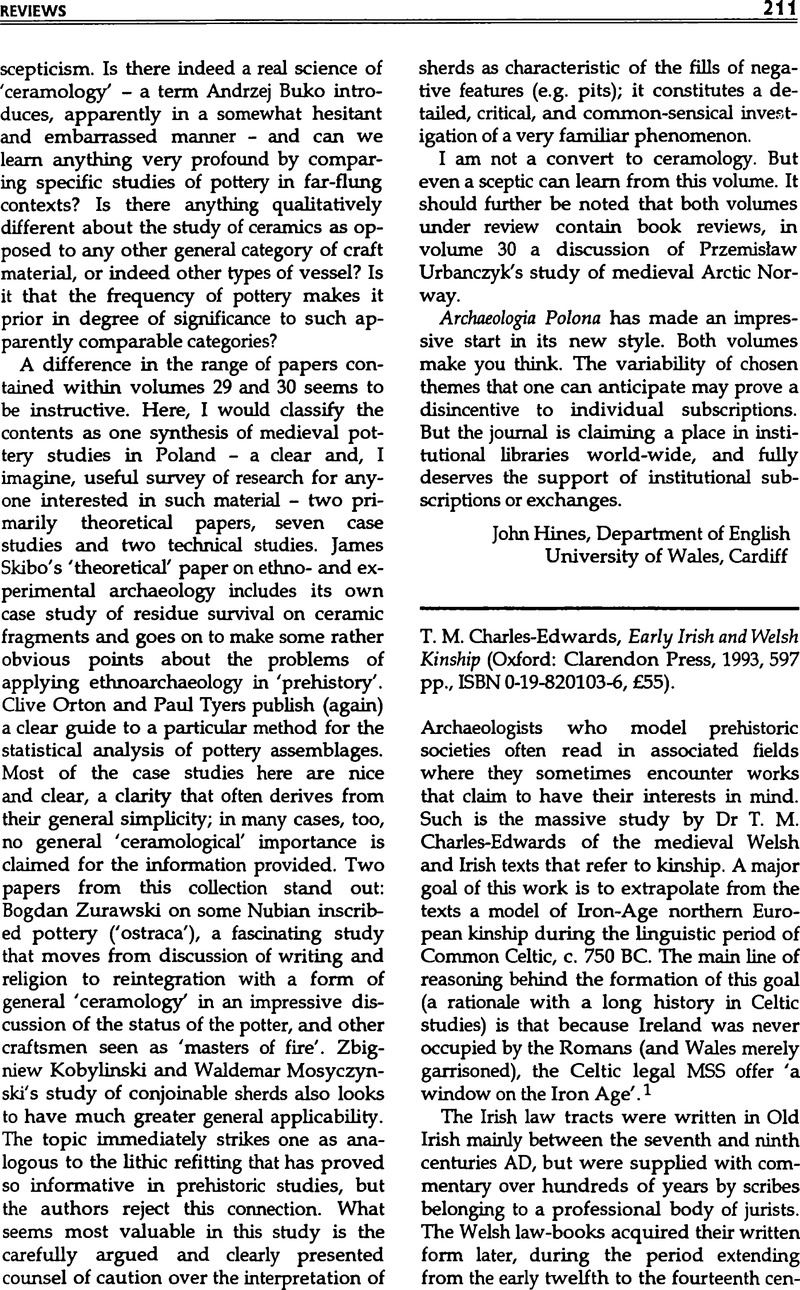No CrossRef data available.
Article contents
T. M. Charles-Edwards, Early Irish and Welsh Kinship (Oxford: Clarendon Press, 1993, 597 pp., ISBN 0-19-820103-6, £55).
Published online by Cambridge University Press: 27 January 2017
Abstract

- Type
- Reviews
- Information
- Copyright
- Copyright © European Association of Archaeologists
References
Notes
1. Kenneth Jackson, 1953. Language and History in Early Britain. Edinburgh.Google Scholar
2. See pp. 8–12 of Jack Goody, 1990. The Oriental, the Ancient, and the Primitive. Cambridge.Google Scholar
3. I have reviewed the texts that are pertinent to the theory of kinship contractionelsewhere: 1990. Patrilineal kinship in early Irish society: the evidence from the Irish law tracts. Bulletin of the Board of Celtic Studies 37: 133–165.Google Scholar
4. I have suggested and discussed this hypothesis elsewhere: 1991. Cattle-lords and Clansmen: Kinship and Rank in Early Ireland. New York: Garland; forthcoming in second edition by Notre Dame University Press.Google Scholar
5. C. Lynn, 1988. Deer park farms. In I. Bennett (ed.), Excavations: 9; personal communication, 1992; Matthew Stout, 1991. Ringfortsin the south-west Midlands of Ireland. Proceedings of the Royal Irish Academy 91, C, no. 8: 202–243; F. McCormick, 1983. Dairying and beef production in early Christian Ireland: the faunal evidence. In T. Reeves-Smyth and F. Hamond (eds), Landscape Archaeology in Ireland: 253–267. Oxford: British Archaeological Reports (Brit. Ser. 116).Google Scholar
6. T. Charles-Edwards, 1970–2. Some Celtic kinship terms. Bulletin of the Board of Celtic Studies 24: 105–122.Google Scholar
7. C. Bernard, 1865. An Introduction to the Study of Experimental Medicine. New York, reprinted 1927. Original p. 188 cited and discussed on pp. 94–95 by George Vaillant, 1993. Self-deceptions of everyday life. The Wisdom of the Ego. Cambridge, Mass.Google Scholar
8. See pp. 227–237 of Jack Goody, 1983. The Development of the Family and Marriage in Europe. Cambridge.Google Scholar
9. Alexander C. Murray, 1983. Germanic Kinship Structure. Toronto.Google Scholar
10. See pp. 5–6 and 39–40 of Herwig Wolfram, 1988. History of the Goths. Berkeley. Trans. by Thomas Dunlop.Google Scholar
11. Sally Humphreys, 1978. Anthropology and the Greeks. London; Mike Rowlands, 1980. Kinship, alliance and exchange in the European Bronze Age. In John Barrett and Richard J. Bradley (eds), Settlement and Society in the Later British Bronze Age: 19ff. Oxford: British Archaeological Reports (Brit. Ser. 83); Pages 175–176 of Françis Audouze and Olivier Buchsenschutz, 1991. Towns, Villages and Countryside of Celtic Europe. London: Batsford (originally 1989, Paris: Hachette).Google Scholar
12. The inheritance communities of the early Middle Ages, like their Roman counterparts, were voluntary associations whose dissolution could occur at any time … They were not … the remnants of corporate clan and lineage organization. But because the co-heirs were frequently siblings or cousins, the community might constitute a shallow descent group’ Murray op. cit. p. 102, my emphasis.Google Scholar




